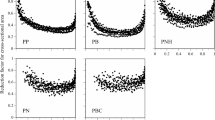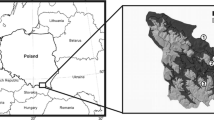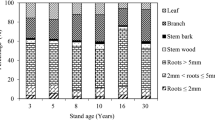Abstract
The tissue structure of a bamboo stem (culm) differs from that of woody species, exhibiting a large cavity in the internode surrounded by a cortex with high silica concentration. Thus, to obtain an accurate estimation of the necromass, as well as carbon (C) and nitrogen (N) stocks in dead bamboo culms, we examined the basic characteristics of culm structure as well as the C and N concentrations of decomposing culms of Phyllostachys bambusoides and P. heterocycla. We collected dead culms of the two bamboo species from 15 bamboo stands in central and southwestern Japan, and analyzed the relationship between the ratio of wall volume to culm disk volume and culm diameter, as well as the changes of C and N concentrations in dead culms with wall density, which can be used as an indicator of the degree of decomposition. The ratio of wall volume to culm volume tended to decrease with increasing culm diameter for both species. The C concentration did not change, but the N concentration increased with decreasing wall density. The wall density was related to the C/N ratio, which is a chemical parameter of the degree of decomposition. The culm structure should be considered when estimating culm density. The mean C concentration can be used for estimating the C stock of decomposing culms irrespective of decomposition level. N concentration, however, should be determined according to decomposition level for N stock estimation.






Similar content being viewed by others
References
Creed IF, Webster KL, Morrison DL (2004) A comparison of techniques for measuring density and concentrations of carbon and nitrogen in coarse woody debris at different stages of decay. Can J For Res 34:744–753. doi:10.1139/X03-212
Currie WS, Nadelhoffer KJ (2002) The imprint of land-use history: patterns of carbon and nitrogen in downed woody debris at the Harvard Forest. Ecosystems 5:446–460. doi:10.1007/s10021-002-1153-x
Holub SM, Spears JDH, Lajtha K (2001) A reanalysis of nutrient dynamics in coniferous coarse woody debris. Can J For Res 31:1894–1920. doi:10.1139/cjfr-31-11-1894
Imai T, Majima S, Fujita M, Saiki H (1995) Cellular structures in culm internodes of three Phyllostachys species, Madake, Hachiku and Mosochiku (1). Bull Kyoto Univ For 65:147–157, In Japanese with English summary
Isagi Y, Kawahara T (1988) Decomposition traits of culms of bamboo (Phyllostachys heterocycla (Carr.) Mitf.) on forest floor. Bamboo J 6:37–42, In Japanese
Isagi Y, Kawahara T, Kamo K (1993) Biomass and net production in a bamboo Phyllostachys bambusoides stand. Ecol Res 8:123–133. doi:10.1007/BF02348524
Isagi Y, Kawahara T, Kamo K, Ito H (1997) Net production and carbon cycling in a bamboo Phyllostachys pubescens stand. Plant Ecol 130:41–52. doi:10.1023/A:1009711814070
Kottek M, Grieser J, Beck C, Rudolf B, Rubel F (2006) World map of the Köppen-Geiger climate classification, updated. Meteorol Z 15:259–263. doi:10.1127/0941-2948/2006/0130
Lambert RL, Lang GE, Reiners WA (1980) Loss of mass and chemical change in decaying boles of a subalpine balsam fir forest. Ecology 61:1460–1473. doi:10.2307/1939054
Lamlom SH, Savidge RA (2003) A reassessment of carbon content in wood: variation within and between 41 North American species. Biomass Bioenerg 25:381–388. doi:10.1016/S0961-9534(03)00033-3
Liese W (1998) The anatomy of bamboo culms. International Network for Bamboo and Rattan, Beijing
Lobovikov M, Paudel S, Piazza M, Ren H, Wu J (2007) World bamboo resources. A thematic study prepared in the framework of the Global Forest Resources Assessment 2005. Food and Agriculture Organization of the United Nations, Rome
Mäkinen H, Hynynen J, Siitonen J, Sievänen R (2006) Predicting the decomposition of Scots pine, Norway spruce, and birch stems in Finland. Ecol Appl 16:1865–1879. doi:10.1890/1051-0761(2006)016[1865:PTDOSP]2.0.CO;2]
Palviainen M, Finér L, Laiho R, Shorohova E, Kapitsa E, Vanha-Majamaa I (2010) Carbon and nitrogen release from decomposing Scots pine, Norway spruce and silver birch stumps. For Ecol Manag 259:390–398. doi:10.1016/j.foreco.2009.10.034
Shanmughavel P, Francis K (1996a) Biomass and nutrient cycling in bamboo (Bambusa bambos) plantations of tropical areas. Biol Fertil Soils 23:431–434. doi:10.1007/BF00335918
Shanmughavel P, Francis K (1996b) Effect of fertilization on Bambusa bambos plantations. J Non-timber For Prod 3:23–25
Shanmughavel P, Francis K (1997) Balance and turnover of nutrients in a bamboo plantation (Bambusa bambos) of different ages. Biol Fertil Soils 25:69–74. doi:10.1007/s003740050282
Singh AN, Singh JS (1999) Biomass, net primary production and impact of bamboo plantation on soil redevelopment in a dry tropical region. For Ecol Manag 119:195–207. doi:10.1016/S0378-1127(98)00523-4
Takahashi M, Furusawa H, Limtong P, Sunantha Pongsuk V, Marod D, Panuthai S (2007) Soil nutrient status after bamboo flowering and death in a seasonal tropical forest in western Thailand. Ecol Res 22:160–164. doi:10.1007/s11284-006-0194-6
Torii A (1998) Estimation of range expansion rate of bamboo stands using aerial photographs—Case study on Mt. Hachiman, Shiga Prefecture, and Mt. Otoko, Kyoto Prefecture, Japan. Jpn J Ecol 48:37–47, In Japanese with English summary
Torii A, Isagi Y (1997) Range expansion of bamboo species in southern areas of Kyoto Prefecture, Japan. Jpn J Ecol 47:31–41, In Japanese with English summary
Tripathi SK, Singh KP (1992) Nutrient immobilization and release patterns during plant decomposition in a dry tropical bamboo savanna, India. Biol Fertil Soils 14:191–199. doi:10.1007/BF00346060
Tripathi SK, Singh KP (1994) Productivity and nutrient cycling in recently harvested and mature bamboo savannas in the dry tropics. J Appl Ecol 31:109–124
Tripathi SK, Singh KP (1996) Culm recruitment, dry matter dynamics and carbon flux in recently harvested and mature bamboo savannas in the Indian dry tropics. Ecol Res 11:149–164. doi:10.1007/BF02347681
Watanabe M, Inoue M, Takano T (1989) Discussion of the prediction of culm height in Phyllostachys bambusoides bamboos. Bamboo J 7:27–38
Yang FF, Li YL, Zhou GY, Wenigmann KO, Zhang DQ, Wenigmann M, Liu SZ, Zhang QM (2010) Dynamics of coarse woody debris and decomposition rates in an old-growth forest in lower tropical China. For Ecol Manag 259:1666–1672. doi:10.1016/j.foreco.2010.01.046
Acknowledgements
We are grateful to researchers of the prefectural forest research institutes for collecting the dead culm samples. We thank the members of the Department of Forest Site Environment, the Bureau of Climate Change, and the Department of Wood Processing of the Forestry and Forest Products Research Institute for their help with this research. In particular, we thank Y. Itakura (Department of Wood Processing, Forestry and Forest Products Research Institute) and H. Takahashi, A. Tagawa, M. Nemoto, and Y. Katsui (Department of Forest Site Environment, Forestry and Forest Products Research Institute) for analyzing dead culm samples. This study was supported by the National Forest Soil Carbon Inventory managed by the Forestry Agency in Japan.
Author information
Authors and Affiliations
Corresponding author
Additional information
Responsible Editor: Alfonso Escudero.
Electronic supplementary materials
Below is the link to the electronic supplementary material.
Supplement table 1
Coefficient of explanatory variable in general linear model (Formula 1′–4′). The coefficient means “b” in each formula. Asterisk shows significant difference from 0 (*, p ≦ 0.05; **, p ≦ 0.01) (DOC 53 kb) (DOC 53 kb)
Supplement table 2
Results of linear and non-linear regressions with Gaussian errors. No random effect was incorporated into the linear and non-linear regressions (DOC 64 kb) (DOC 64 kb)
Rights and permissions
About this article
Cite this article
Ugawa, S., Miura, S., Matsuura, Y. et al. Characteristics of culm structure and carbon and nitrogen concentrations in dead bamboo culms of two Phyllostachys species. Plant Soil 347, 269–278 (2011). https://doi.org/10.1007/s11104-011-0844-5
Received:
Accepted:
Published:
Issue Date:
DOI: https://doi.org/10.1007/s11104-011-0844-5




